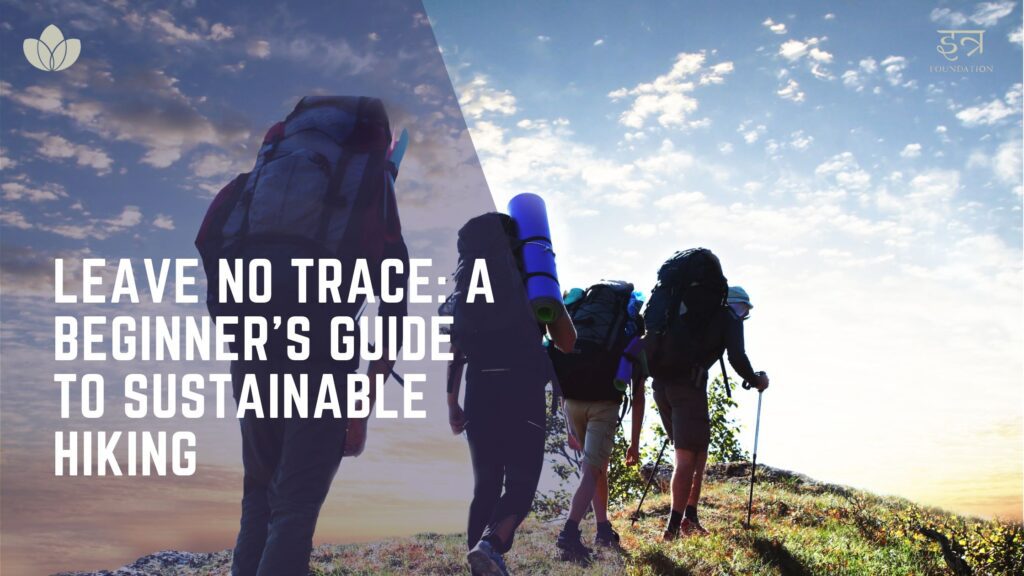Sustainable hiking is a form of outdoor recreation that prioritizes the preservation of the environment and the protection of natural resources for future generations. It involves hiking in a responsible and environmentally-friendly manner, taking steps to minimize the impact of human activities on the environment. Sustainable hiking practices include respecting wildlife and their habitats, following Leave No Trace principles, reducing waste and preserving cultural and historical sites. By following these guidelines, hikers can help maintain the beauty and ecological integrity of the natural areas they visit for future generations to enjoy. Additionally, sustainable hiking also helps protect the health and well-being of the local communities, wildlife, and ecosystem. In short, sustainable hiking is an important way to ensure the long-term preservation of the environment and the responsible enjoyment of the great outdoors.

What is Sustainable Hiking?
Sustainable hiking is a concept that involves responsible and environmentally friendly hiking practices. It is a way of exploring nature while minimizing its impact on the environment. The goal of sustainable hiking is to preserve the natural beauty and resources of our trails and parks for future generations to enjoy. This involves following practices such as leaving no trace, avoiding sensitive areas, and minimizing waste. Hikers are encouraged to be mindful of their impact on the environment and to adopt eco-friendly habits, such as carrying out their own trash and avoiding damaging vegetation and wildlife. By practicing sustainable hiking, we can ensure that our natural spaces remain healthy and vibrant for years to come
Sustainable hiking is important because it helps to preserve the natural beauty and ecological integrity of our outdoor environments. Hiking is a popular and enjoyable outdoor activity, but it can also have negative impacts on the environment if proper practices are not followed. The excessive use of trails, improper disposal of waste and the disturbance of wildlife and their habitats can all contribute to environmental degradation. By adopting sustainable practices when hiking, we can reduce our impact on the environment and help to preserve it for future generations to enjoy. This includes following Leave No Trace principles, such as staying on designated trails, respecting wildlife and properly disposing of waste. By taking a proactive approach to hiking sustainably, we can ensure that our outdoor environments remain healthy and vibrant for many years to come.
Unsustainability in hiking can have significant impacts on the environment, including the degradation of natural habitats, loss of biodiversity, and soil erosion. Unsustainable hiking practices, such as cutting trails, leaving behind litter and camping in sensitive areas, can result in long-lasting damage to delicate ecosystems. These practices can disrupt the delicate balance of nature and harm wildlife, as well as interfere with the natural water cycles, causing soil erosion and degradation of soil quality. In addition, unsustainability in hiking also contributes to climate change and the degradation of natural resources, which can have far-reaching consequences for future generations. By adopting sustainable practices while hiking, we can help to protect the environment and preserve it for future generations to enjoy.
Why Sustainable hiking is Important?
Impact of Hiking on the Environment: Hiking can have a significant impact on the environment, especially in sensitive and fragile ecosystems. Unsustainable hiking practices, such as off-trail hiking and littering, can cause harm to the environment and its wildlife. By adopting sustainable hiking practices, we can minimize our impact on the environment and preserve it for future generations to enjoy.
Preserving Natural Resources and Habitats: Hiking in natural areas often involves the use of natural resources, such as water and firewood. By practicing sustainable hiking, we can conserve these resources and preserve the natural habitats of the wildlife that live in these areas.
Contribution to Conservation Efforts: Sustainable hiking is not just important for the environment and its resources, but it also helps contribute to larger conservation efforts. By following sustainable practices, we can help protect the environment from further harm and preserve it for future generations to enjoy. In this way, sustainable hiking plays an important role in preserving the earth’s natural beauty and biodiversity for future generations to experience.
Hiking sustainably is not just about leaving a smaller footprint but also about preserving natural beauty and resources for future generations to enjoy. In order to hike sustainably, it is important to follow the Leave No Trace Principles, which include proper waste management and disposal, minimizing disturbance to wildlife and habitats, and respecting natural resources. Additionally, it is crucial to reduce your carbon footprint and conserve energy while hiking. This can be done by taking steps such as packing out all of your trash, avoiding disturbing wildlife and their habitats, and minimizing the use of energy-intensive equipment. By following these guidelines, you can ensure that your hiking experience is not only enjoyable for you, but also for the environment and for future generations.”
How to Hike Sustainably
Leave No Trace Principles: This is a set of principles that encourage outdoor enthusiasts to minimize their impact on the environment. This includes leaving the trail as you found it, not disturbing wildlife and minimizing your impact on vegetation.
Importance of Proper Waste Management and Disposal: Proper waste management and disposal is crucial to reducing the impact of hiking on the environment. This includes carrying out all trash, not leaving any food waste behind, and using designated waste bins where available.
Importance of Minimizing Disturbance to Wildlife and Habitats: Hiking can have a significant impact on wildlife and habitats. By being mindful of your surroundings and taking steps to minimize your impact, you can help protect the ecosystem and preserve it for future generations.
Importance of Respecting Natural Resources and Protecting Them for Future Generations: Natural resources such as water and vegetation are essential for the survival of wildlife and must be respected and protected. Hikers should take steps to minimize their impact on these resources, such as avoiding trampling on vegetation and not littering.
Tips for Reducing Your Carbon Footprint and Conserving Energy: Hiking can also have an impact on the environment through the release of greenhouse gases and the use of energy. To reduce your carbon footprint, consider using environmentally-friendly transportation options, such as carpooling and carrying reusable water bottles instead of disposable ones. By following these tips, you can help conserve energy and protect the environment for future generations.
It is our responsibility as hikers to adopt sustainable practices and take care of the environment. We should strive to leave no trace, protect wildlife and habitats and preserve natural resources. By doing so, we can ensure that future generations have access to the same pristine natural environments that we have today.
In the end we would like to sum it up by saying it is important to recognize the impact that we have on the environment and to take steps to minimize it. Sustainable hiking is just one way that we can contribute to the preservation of our planet and leave a positive legacy for future generations. So, let us all make a conscious effort to hike sustainably and preserve the beauty and majesty of our natural world.


